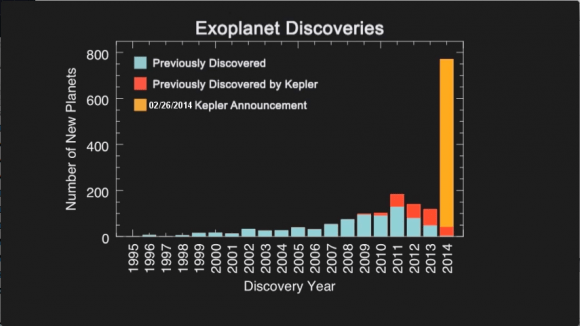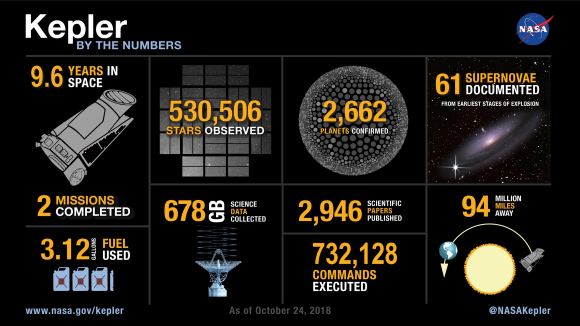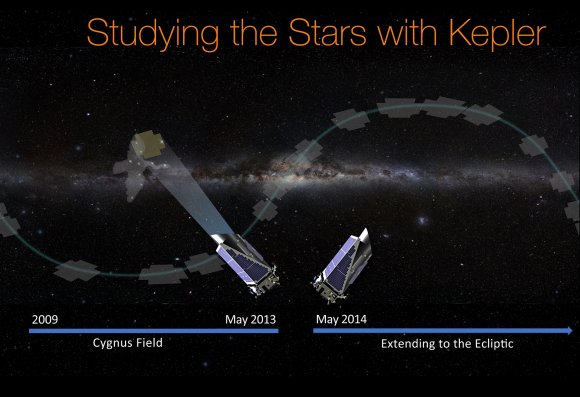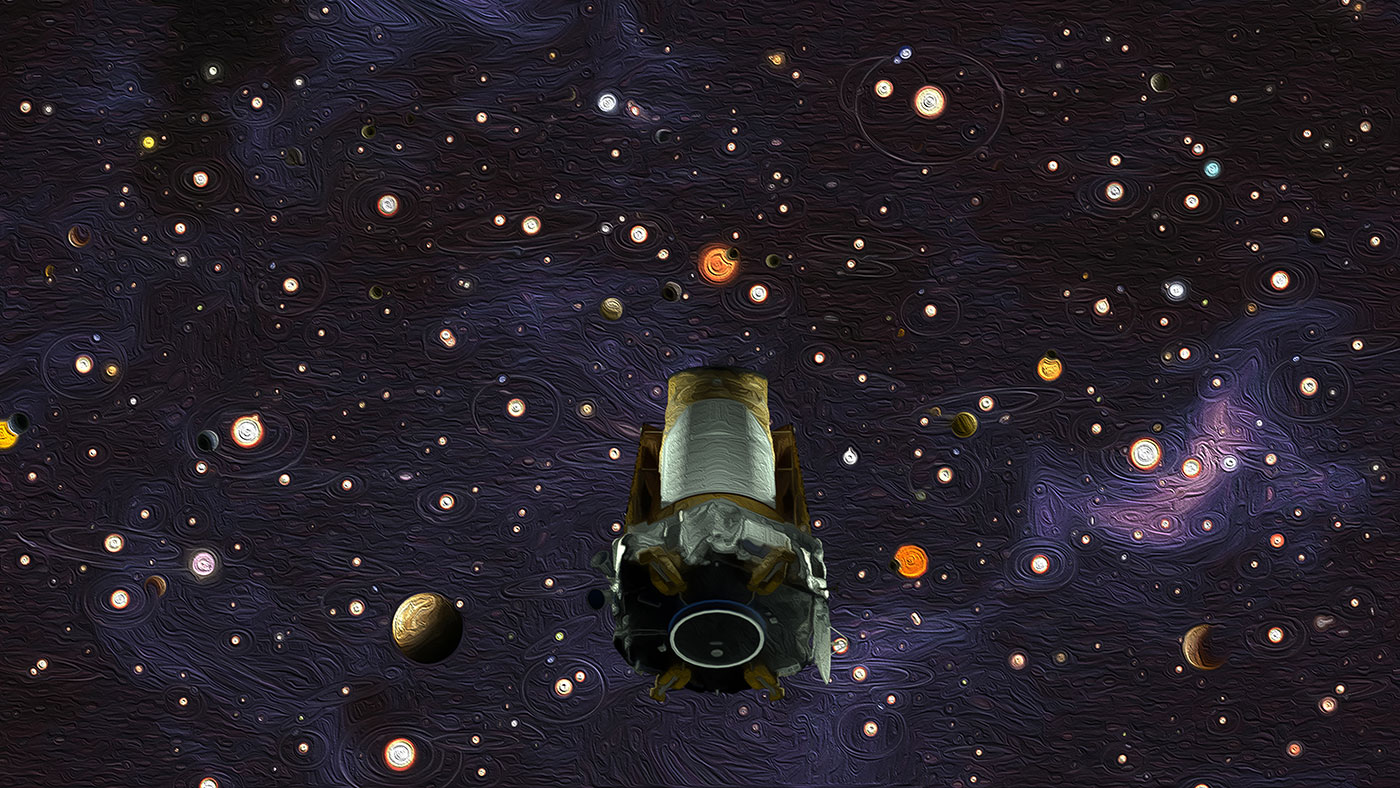It’s been quite a tumultuous time for space telescopes lately! Less than a month ago, the Hubble Space Telescope went into safe mode after experiencing a mechanical failure with one of its gyroscopes (which has since been remedied). Shortly thereafter, the Chandra X-ray telescope went into safe mode as well, and for similar reasons. After three days, it’s operations team managed to get it back in working order as well.
And now, after nine years of service, NASA has officially announced that the Kepler Space Telescope will be retiring. With no fuel remaining to conduct its science observations, NASA has decided to leave the telescope in its current safe orbit (well away from Earth). Far from being a sad occasion, Kepler’s retirement is an opportunity to reflect upon the immense accomplishments of this telescope and how it revolutionized the study of exoplanets.
With its launch in March 6th, 2009, Kepler began an ambitious mission: to survey our region of the Milky Way in search of Earth-size planets that orbited within (or near to) their stars respective habitable zones and determine how many of the hundreds of billions of stars in our galaxy might have such planets. In its time, it has been responsible for the discovery of 2,600 confirmed planets, and almost 4000 candidates.
As Thomas Zurbuchen, the associate administrator of NASA’s Science Mission Directorate in Washington, declared in a recent NASA press release:
“As NASA’s first planet-hunting mission, Kepler has wildly exceeded all our expectations and paved the way for our exploration and search for life in the solar system and beyond. Not only did it show us how many planets could be out there, it sparked an entirely new and robust field of research that has taken the science community by storm. Its discoveries have shed a new light on our place in the universe, and illuminated the tantalizing mysteries and possibilities among the stars.”
In order to detect distant exoplanets, Kepler relied on what is known as the Transit Method (aka. Transit Photometry). This method consists of measuring the light curves of distant stars for periodic dips in brightness, which are an indication that exoplanets are passing in front of them (i.e. transiting) relative to the observer. Using this method, astronomers are able to place constraints on a planet’s size, orbital period and mass, which helps them to determine if the planet is rocky and potentially-habitable.
Since transits are very brief, Kepler monitored thousands of stars simultaneously within specific fields and avoided the obscuring light from the Sun. Hence why Kepler was focused on the Cygnus and Lyra constellation, which have the largest possible number of stars while also not being within the ecliptic plane (the path of the Sun).

What made Kepler so effective in its mission was the way it combined cutting-edge techniques for measuring a star’s brightness with the largest outer space digital camera at that time. With its instrument aimed at one field of stars after another, Kepler conducted the first survey of planets in our galaxy and became NASA’s first mission to search for potentially habitable exoplanets.
Leslie Livesay, the director for astronomy and physics at NASA’s Jet Propulsion Laboratory, also served as Kepler’s project manager during mission development. As she summarized:
“The Kepler mission was based on a very innovative design. It was an extremely clever approach to doing this kind of science. There were definitely challenges, but Kepler had an extremely talented team of scientists and engineers who overcame them.”
Thanks to the almost 3000 planets Kepler has confirmed, astronomers have learned a great deal about the diversity of planets that exist within our galaxy. Of all the exoplanets that have been detected and confirmed so far, the majority have fallen into one of three categories: gas giants, hot-super-Earths in short period orbits, and ice giants.

However, based on the most recent analysis of Kepler’s discoveries, astronomers have concluded that 20 to 50% of stars visible in the night sky are likely to have planets that are similar in size and composition (i.e. rocky) to Earth. These planets would also be located within their parent stars habitable zones, meaning that they would be warm enough to support liquid water on their surfaces.
Another thing that Kepler opened our eyes to is how divergent other systems can be from our own. For instance, the most common type of planet it observed (those that are between the size of Earth and Neptune) doesn’t even exist in our Solar System. In addition, Kepler found planetary systems that were so packed with planets orbiting close to their stars that it made the Solar System look sparsely populated by comparison.
Said William Borucki, the Kepler mission’s founding principal investigator from NASA’s Ames Research Center (now retired):
“When we started conceiving this mission 35 years ago, we didn’t know of a single planet outside our solar system. Now that we know planets are everywhere, Kepler has set us on a new course that’s full of promise for future generations to explore our galaxy.”

Because of its success rate, the astronomical community received a bit of a fright when mechanical failures occurred four years into its mission (after Kepler had met its primary mission objectives). This consisted of one of Kepler’s gyroscope-like reaction wheels (which are used to precisely point the telescope) failing in July 2012, followed by a second wheel failing in May of 2013.
After months of analysis, the mission team abandoned restoring the telescope to full working order and devised a secondary mission – known as K2. For this mission, the team switched the spacecraft’s field of view roughly every three months, which doubled the life of the telescope and increased the number of Kepler’s surveyed stars to more than 500,000.
The observation of so many stars was also a major contribution, allowing astronomers to better understand stellar behaviors and properties – which are essential to studying the planets that orbit them. The data it collected is also allowing astronomers to learn more about the history of our Milky Way and stellar evolution, which is yielding insight into the history and evolution of our Universe.
The extended missions also set a precedent for data-sharing, where new observations were immediately made available to the public. This allowed for a very rapid discovery process and has set a new standard which future missions hope to follow. Despite the fact that the Kepler mission is now at an end, scientists anticipate that they will be studying the volumes of data it obtained for at least a decade.
“We know the spacecraft’s retirement isn’t the end of Kepler’s discoveries,” said Jessie Dotson, Kepler’s project scientist at NASA’s Ames Research Center. “I’m excited about the diverse discoveries that are yet to come from our data and how future missions will build upon Kepler’s results.”
Even though the mission has contributed to almost 3000 scientific papers already, the Kepler team published a white paper that offers suggestions about where important scientific discoveries could still be made using the mission data. They also included a list of 21 important data analysis projects which can be executed using data that is already available in the Kepler archives today.
The data obtained as part of Kepler’s last campaign (Campaign 19), will also complement data from NASA’s Transiting Exoplanet Survey Satellite (TESS), which launched back in April. TESS and the James Webb Space Telescope (JWST) – which is scheduled to launch in 2021 – will pickup where Kepler left off, surveying nearby star systems in the hopes of finding habitable planets and answering the fundamental question: are we alone in the Universe?
Here’s to you Kepler! You did great and were gone too soon. May those who follow in your footsteps live up to the standard you set!
Further Reading: NASA


Transit Photometry- that would require: (1) planet of a distant star to happen to orbit in a path that crosses the line of sight of the telescope, (2) planet and the distant star do not move relative to the telescope that may affect the transit view.